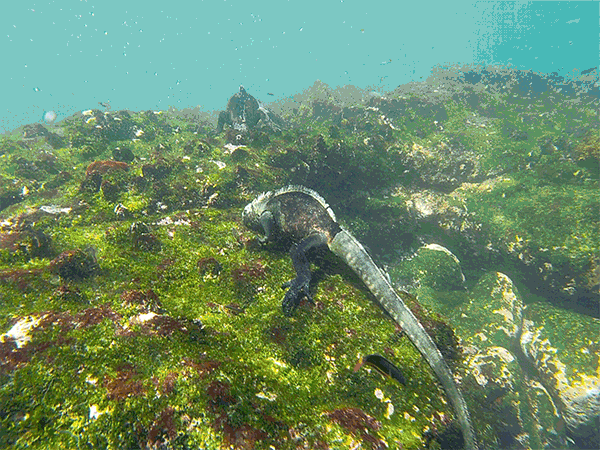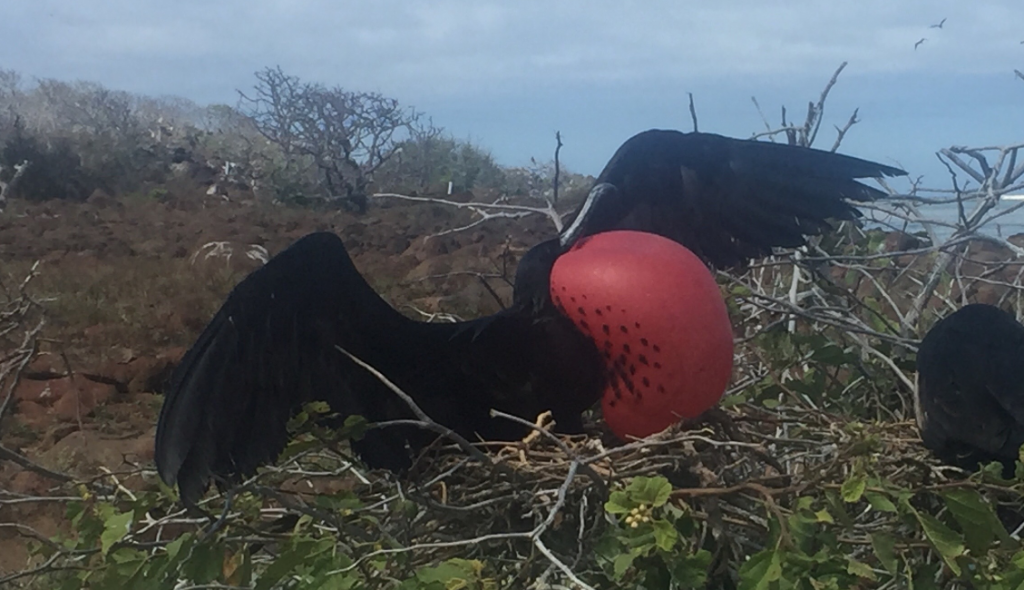Samir, one of our travel specialist team leaders, has returned from a trip to the Galapagos Islands. Here he shares the 5 things he enjoyed most.
Highlands & Darwin Research Centre, Santa Cruz Island
The Highlands and Darwin Research are located on Santa Cruz Island and are a typical pit stop for cruise going visitors as it is en route to Puerto Ayora from Baltra airport. This was the perfect start to my Galapagos adventure and got my taste buds salivating. As the bus worked its way along the only road from the north side of the island, the desert-like terrain slowly transitioned into lush green vegetation. I was entering the home of a local resident that I had been waiting to encounter for a very long time – the giant tortoise! The water saturated Highlands provide the perfect conditions for the giant tortoise and their insatiable appetite. This can almost be slaked by a wide variety of vegetation that can be found here including exotic fruits such as papaya, mango, cacao and guava (one of their favourites).
The first thing that strikes you is the sheer size of the fully-grown males as they can weigh up to 250kg! This is closely followed by the fact we do not know their exact age as humans have only been in the Galapagos for a couple of hundred years. This means that this big guy (pictured) could be 100, 120 or even 150 years old! We just don’t know. Mind-boggling.
They were initially hunted in huge numbers by whalers as a food source due to their hardiness and ability to stay alive out at sea without food or water. Only 10% of the original population remains, which has led to their endangered status today.


After this short visit, we were back on the road and headed to Puerto Ayora, the main port in the Galapagos. Upon arrival, we went up to the Darwin Research Centre. Inaugurated in 1964, this is an operative branch of the Charles Darwin Foundation and provides a base for the restoration, conservation and sustainability efforts being made in the Galapagos.
Home to many animals in its breeding centres, it also has a really informative and interesting exhibition hall for guests. Being a bit of geek, I headed in smacking my lips and spent about an hour absorbing as much as I could and getting a foundation for the rest of my trip. The work they are doing is really impressive and gave me a sense of hope for this extremely vulnerable set of islands.


Snorkelling at Devil’s Crown, Floreana Island
Okay, so I should start by saying that snorkelling is definitely not one of my strong suits (only been once before in my life). However, this was one of my favourite activities I did in the Galapagos and easily slots into my top travel highlights.
From the surface it was just impossible to grasp how much the ocean there is teeming with life and within a few minutes of being underwater, I was really blown away. Despite nearly drowning the first time I jumped in from the zodiac (I must have swallowed so much sea water through my snorkel – like I said, it’s not my strong suit!), I eventually managed to get the hang of it and thoroughly enjoyed the experience. The clarity of the water was remarkable and allowed to me to see more marine species in one place than I ever could have imagined. Marine iguanas, Sea turtles, Galapagos sharks, white-tipped reef sharks, Rays, Sea lions…and I haven’t even started on the school of schools of tropical fish! Incredible experience!

Incredible birdlife, North Seymour Island
I visited North Seymour Island on my second to last day in the Galapagos and it was definitely worth the wait. Being one of the smaller islands in the Archipelago it was formed by an uplifting of underwater volcanic lava, which means the terrain is very flat. Coupled with the low bushy vegetation it is ideal for bird breeding. A few minutes after landing, I realised just how much of an ideal place it really was as I was standing in front of an impressive colony of Frigate birds; Great and Magnificent alike. Along with scores of blue-footed boobie in their designated nests with their offspring. As I strolled along the trail, I was mesmerized by life on this small island while the guide filled us in on the complexity and simplicity of all the mating rituals for each species.
The most impressive and striking bird, in my opinion, would have the be the Great and Magnificent frigate birds. As they mate all year round, we were spoiled with a mating ritual unlike anything I have ever seen before. Inflating their prominent red pouches to the size of a football, the frigate bird sits on a branch trying to attract a potential mate. These males will keep their pouches inflated for up to two weeks at a time. I thought their dedication to the cause was notable. Also, in order to increase their chances of success, they will not move from their spot to hunt either. Hungry work.

Before the end of the trail, I had seen two boobies’ initial mating encounter and start building a nest together, flocks of swallow tail golds, bright vibrant yellow coloured iguanas chilling under cacti and even received a slobbery kiss from a sea lion on the beach! Amazing place and a definite must see!

Espinoza point, Fernandina Island
Fernandina is the youngest island of all the Archipelago and the one I had been eagerly anticipating. Being the youngest (about 700,000 years old), it is yet to host much life as the terrain consists mostly of black lava fields as far as the eye can see. If it weren’t for a couple of cacti dotted around, I could have sworn I was standing on another planet – very cool.

However, where there was life lacking on the land, it was thriving in the sea. Upwellings of nutrient-rich cold water from the Pacific would, in turn, bring schools of fish to the shallows and make it perfect for pelicans, blue-footed boobies to penguin’s hunt for food. I could have watched the scores of pelicans and boobies rocket diving into the water as they caught their next meal.

Post Office Bay, Floreana Island
Where tourists turn post officers and mail can take years to arrive with its intended recipient, welcome to Post Office Bay – the world’s most unusual post office. This has made it into my top travel highlights due to its complete uniqueness. Better known for its abundance of incredible wildlife than postal service, the Galapagos has an adolescent history of human activity. However, this is definitely one that sparked my interest. In the days before email, Facebook and Twitter (18th century to be more specific), travelling whalers came up with a simple yet ingenious method of communication. Perched just of the beach stands a barrel erected from the ground, it was used as a post box for passing ships to carry on mail to their homesick seaman’s families.
Nowadays, it is full of postcards from tourists wishing to carry on the tradition. After a quick search, I managed to find one that is only a few streets away from my house in London – what are the odds! So, in following tradition I posted it by hand when I returned home and left a couple postcards of my own. Who knows when it will be delivered…..
If reading about Samir’s, experience in the Galapagos has whet your appetite for this corner of South America. You can call our travel specialists on 0208 546 6222 to organise your truly individual holiday.

Leave a Reply